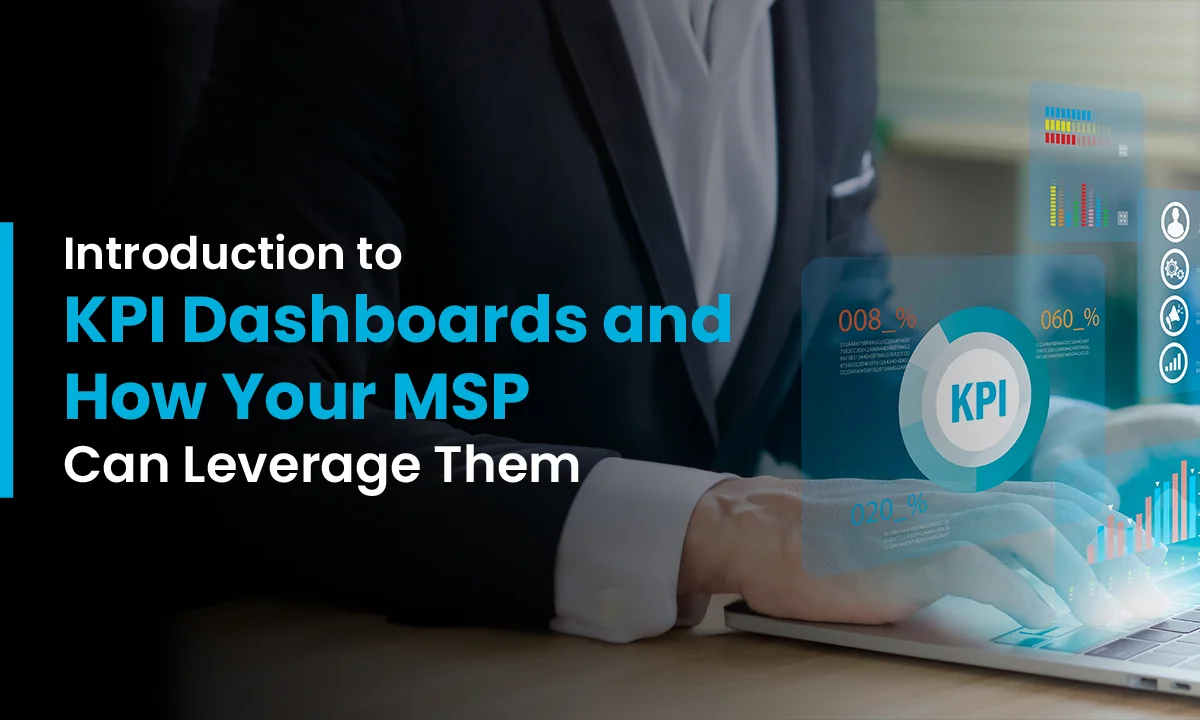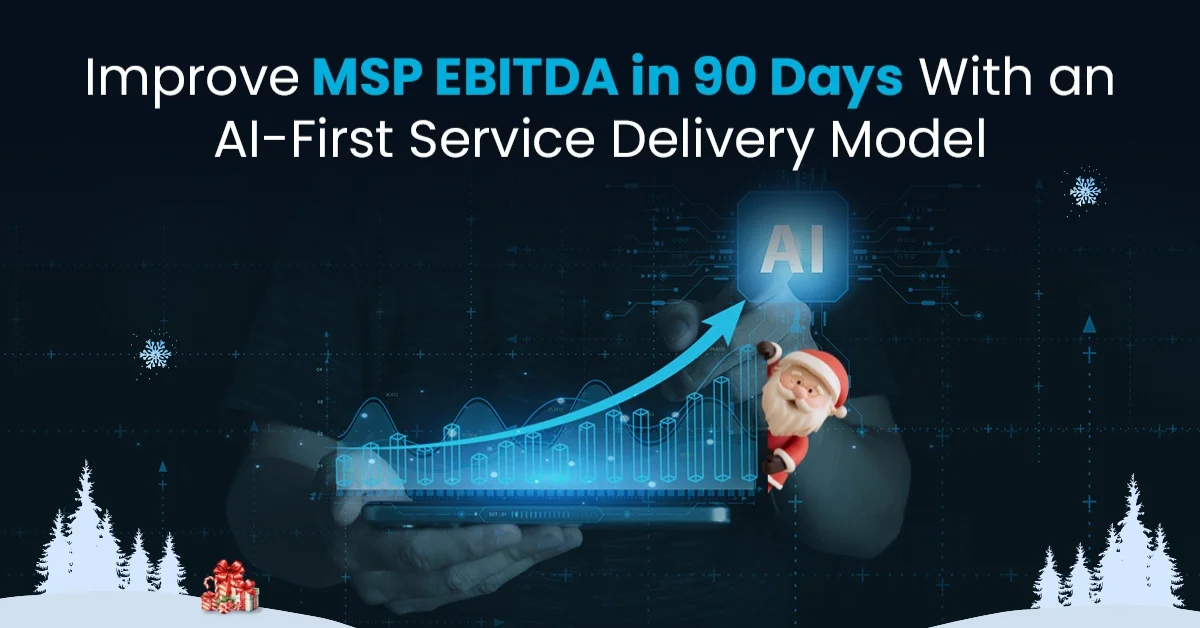Every business has certain indicators that need to be monitored, ranging from long-term aims to business-wide objectives. A dashboard showing data on key performance indicators (KPIs) is one tool for sharing such findings.
When utilized appropriately, in conjunction with other contemporary analytics tools, KPI dashboards are a terrific method for you to enhance the management of strategic goals and stay abreast of changes, challenges and trends in performance at a high level.
Key performance indicator dashboards not only serve as a visual representation of your MSP’s performance but also act as a guiding tool for your team members. With a well-designed dashboard, you can provide your team with clear insights into their performance and how it aligns with the company’s strategic goals.
This blog explains the potential role of key performance indicator dashboards that bring business advantages to your MSP so that you can be sure your clients are making the most of them.
What is a KPI Dashboard?
Key performance indicators are shown in interactive graphs and charts on a ey performance indicator dashboard, making it easy to quickly evaluate and analyze data in a structured manner. Quantifiable measurements of performance over time for certain strategic goals are known as key performance indicators. You may quickly examine the data behind the KPIs and find insights that can be put into practice with the help of modern key performance indicator dashboards. In this way, a dashboard tool transforms massive data sets from across your MSP into data-driven decisions that can improve your business.
Benefits of Key Performance Indicator Dashboards
When implemented properly, this dashboard tool may provide your MSP with the following six major advantages:
- Detailed dive: Rather than having to sift through uncrated, unfiltered datasets, analytics dashboard enables you to organize, filter, drill down, analyze and visualize your most crucial key targets for any given business area or project in a highly interactive way. This usually helps translate large, complex data into an understandable format.
- Find changes or problems on a large scale: Having an organized dashboard that places important KPIs next to each other makes it easy and quick for you to identify which outcomes are being met in accordance with targets and which may require priority or in-depth investigation to take effective corrective action. This is true whether the KPIs are divided up by department, overarching objectives, or high-level targets.
- Effective decision-making: Key performance indicator dashboards consolidate your MSP’s most important operational data into one easily accessible location, assisting in the removal of data silos within your MSP, increasing the visibility of KPI reporting overall and boosting productivity when it comes to performance analysis, goal setting, investment allocation and streamlining your processes.
- Increased collaboration: Better communication and collaboration among users are fostered by having a high-level visual summary of progress toward the attainment of KPIs. This is because everyone has instant access to the same dashboards and shared visibility, making it easier to discuss performance and identify areas where your team can work together to improve it.
- Real-time ROI analysis: By monitoring and analyzing your MSP’s most crucial performance metrics in real time, you can determine which investments and decisions have been successful and to what extent. This information enables more proactive analysis and the potential to improve long-term financial outcomes.
- Find new possibilities and trends: This analytics dashboard assists you in seeing patterns in your data, identifying possible opportunities and areas of strength (or underperformance) to clarify or improve your goals, and enhancing your MSP’s overall performance.
What are KPI Dashboards used for?
A performance indicator dashboard can be used and referred to quickly to track overall progress toward goals, identify potential trends and generally make better data-driven decisions. It functions as a high-level graphical summary of key business objectives or more specific outcomes like departmental targets.
This dashboard tool also enables you to compare and comprehend the specifics underlying the data using accompanying charts and tables. When looking at spreadsheet metrics alone, across many lines of business, you might not be able to quickly draw conclusions. However, interactive data visualization provides new ways to assess the overall performance of your MSP.
Above all, it offers valuable high-level understanding of performance rather than minute details. It serves as a starting point for identifying which aspects of your business can benefit from more in-depth or thorough investigation rather than offering you all the answers.
Most Common Examples of KPI Dashboards
Although each dashboard is different, many fit into one of the four categories listed below, according to its target audience and intended use. Every design has a distinct focus that makes it easier for you to showcase the KPIs that are important to your MSP and tell a compelling tale. The greatest dashboard tools enable you to quickly dive down into the data and gain meaningful insights, regardless of the kind you choose.
Here are four examples of key performance indicator dashboards along with their respective key metrics:
1. Executive KPI Dashboard
A high-level performance monitoring tool designed specifically for executives is an executive key performance indicator dashboard. The goal is to provide you with a thorough overview so that you may decide on the general course and well-being of the company.
The Executive KPI dashboard includes the following critical metrics:
- Monthly Recurring Revenue (MRR): Measures the predictable and recurring revenue earned each month from subscriptions or service contracts.
- Customer Lifetime Value (CLV): Calculates the total revenue expected from a customer throughout their entire relationship with your MSP.
- Customer Churn Rate: Tracks the percentage of customers who stop using your services over a specific period.
- Net Promoter Score (NPS): Gauges customer satisfaction and loyalty, providing insights into customer advocacy and potential growth.
-
Operational KPI Dashboard
A daily management tool for middle management and operational teams is the operational key performance indicator dashboard. Efficiency, production, inventory planning and resource utilization data are frequently included in this dashboard. These analytics aid teams in optimizing everyday operations, identifying bottlenecks and streamlining procedures by offering actionable insights.
The operational KPI dashboard typically includes the following critical metrics:
- Ticket Volume: Monitors the number of support tickets or service requests received and resolved.
- First Response Time: Measures the average time taken to respond to customer inquiries or issues.
- Resolution Time: Tracks the average time taken to resolve customer issues or complete service requests.
- Service Level Agreement (SLA) Compliance: Ensures that support and service delivery meet agreed-upon SLA targets.
- Customer service metrics: For support questions, the average response time, average resolution time, or average customer satisfaction scores.
3. Sales KPI Dashboard
Using the sales key performance indicator dashboard, you can rapidly evaluate the state of your go-to-market company. Sales managers, executives and other stakeholders may quickly and easily monitor important data, evaluate performance and spot gaps before they have a detrimental effect on your company.
The key metrics that are commonly included in the sales KPI dashboard are:
- Lead Conversion Rate: Calculates the percentage of leads that convert into paying customers.
- Sales Pipeline Value: Tracks the total value of all opportunities in the sales pipeline.
- Customer Acquisition Cost (CAC): Measures the cost to acquire a new customer, including sales and marketing expenses.
- Sales Growth: Monitors the growth rate of sales revenue over a specific period.
4. Marketing KPI dashboard
A dashboard created specifically for marketing professionals to assess and improve initiatives is known as a marketing key performance indicator dashboard. This example of a analytics dashboard offers a thorough perspective of marketing performance, assisting marketing teams in evaluating the success of their campaigns, pinpointing the most productive distribution channels and honing their tactics for optimal effect.
The marketing KPI dashboard includes the following key metrics:
- Website Traffic: Measures the number of visitors to your MSP’s website.
- Lead Generation: Tracks the number of leads generated through marketing efforts.
- Conversion Rate: Calculates the percentage of leads that convert into customers.
- ROI of Marketing Campaigns: Evaluates the return on investment for various marketing campaigns and initiatives.
How does Team GPS help you build and manage KPI Dashboards effortlessly?
You can now track and analyze key performance indicators more easily than ever thanks to Team GPS, which transforms key performance indicator dashboard management. You can easily create and maintain dashboard tool that are customized to your MSP needs using user-friendly features and configurable templates of this employee management tool.
You can track important metrics in real time with Team GPS, which will provide you with insightful information about how well your MSP is performing and help you pinpoint areas that need work. You may save time and effort by tracking KPIs manually thanks to our user-friendly interface and automatic functionality.
Talk to us to explore how Team GPS helps you build and manage your KPI Dashboard effortlessly.








